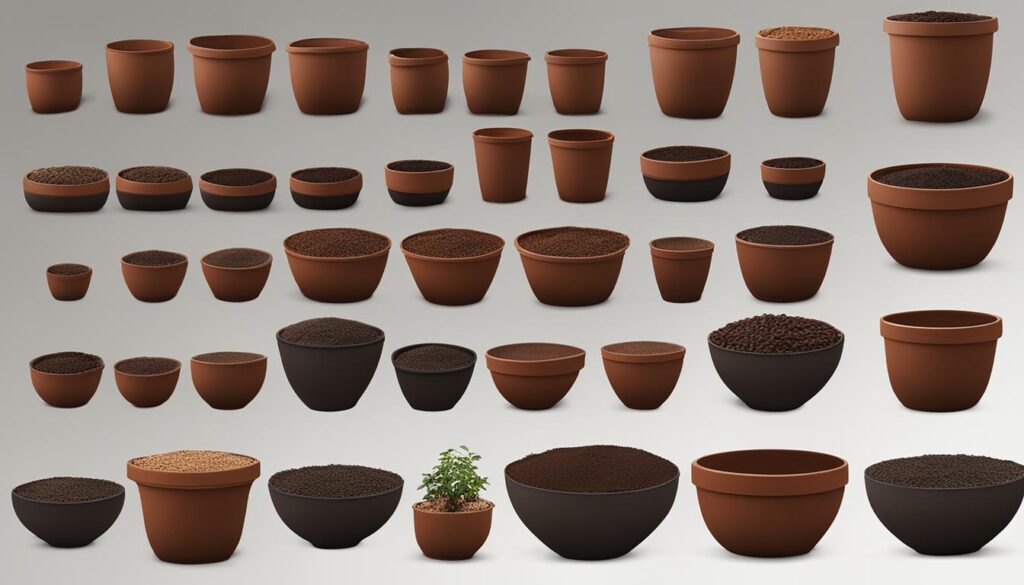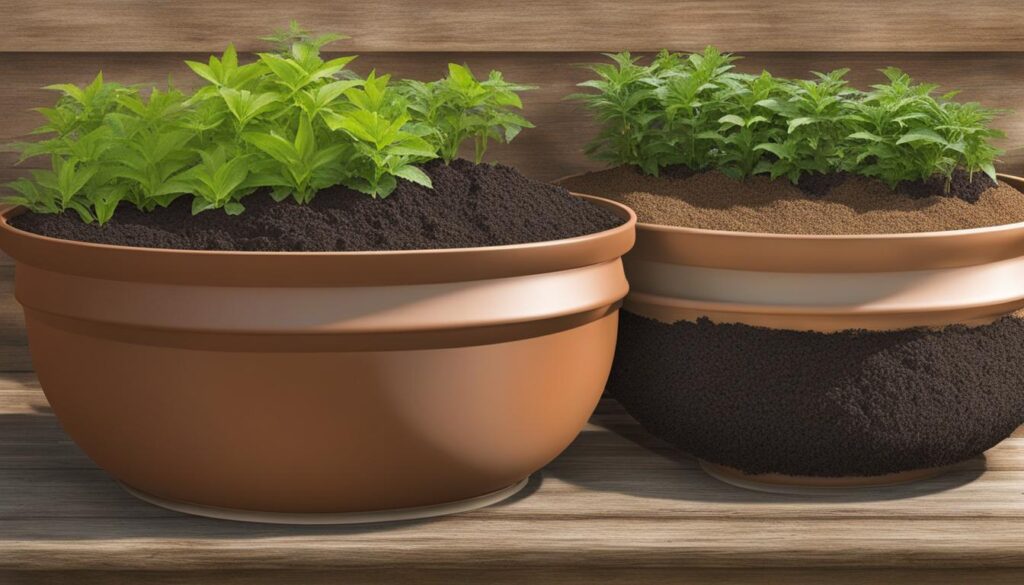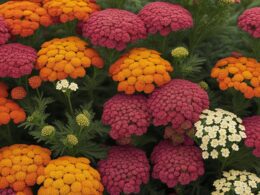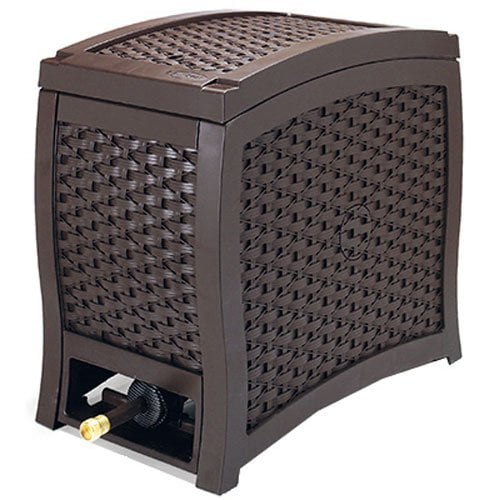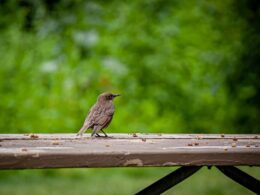Gardening in containers requires careful consideration of soil volume to ensure optimal plant growth. When it comes to determining the amount of soil needed for a 12-inch pot, there are several factors to consider.
Understanding the soil requirements for different pot sizes is essential for successful gardening. Let’s explore how to estimate the soil volume for various pot sizes, factors that can affect soil needs, and the best practices for selecting high-quality soil.
Key Takeaways:
- Choosing the right amount of soil for a 12-inch pot can promote optimal plant growth.
- Estimating soil volume for different pot sizes is important for successful gardening.
- Factors like soil compression and transplanting can affect the overall soil needs.
- Utilizing a soil calculator can simplify the process of determining soil volume.
- Selecting high-quality soil that is well-aerated is crucial for healthy plant development.
Estimating Soil Volume for Different Pot Sizes
When it comes to gardening in containers, knowing how much soil you need for each pot size is crucial. The volume of soil required can vary depending on the size and type of pot you’re using. By estimating the soil volume accurately, you can ensure that your plants have enough room to grow and thrive. Here’s a guide to help you calculate the appropriate amount of soil for different pot sizes.
Pot Types and Sizes
Pots come in various shapes and sizes, from small clay pots to hanging baskets and window boxes. Each pot type has its own soil volume requirements. Here are some examples:
- 8 ¼ inch standard clay pot: Approximately 3.6 dry quarts of soil
- 12-inch hanging basket: Approximately 7.9 dry quarts of soil
- 14-inch basket: Approximately 15.3 dry quarts of soil
Potting Soil Calculation
To estimate the soil volume for different pot sizes, you can refer to a soil volume table or use a soil calculator. These tools can help you determine the specific amount of soil needed based on the dimensions of your pots. By entering the pot’s diameter and height or width and depth, you can easily calculate the required soil volume.
“Using a soil calculator takes the guesswork out of determining the right amount of soil for your pots. It ensures that you have enough soil to support your plants’ growth without wasting any excess.”
Remember, it’s important to consider the type of plant, its root system, and the desired growth space when estimating soil volume. Providing adequate soil is essential for healthy plant development, so take the time to calculate the right amount of soil for each pot size to promote optimal growth.
Factors to Consider When Estimating Soil Needs
When estimating the amount of soil needed for your pots, there are several factors you should consider to ensure you have enough for your gardening needs. These factors can affect the estimation of soil needs and help you plan accordingly.
Soil Compression
Soil compression is a crucial factor to consider when estimating soil needs. When you moisten and press down the soil, it can become compacted, taking up less volume and potentially affecting the overall quantity of soil required. It’s important to account for soil compression, which can add an additional 15% to 20% of dry soil to the container. By anticipating soil compression, you can ensure you have enough soil for your pots.
Transplanting Plants
Another factor to consider is the act of transplanting plants. When you transfer a plant from one container to another, some soil from the original container may move around the roots, affecting the overall volume. It’s important to take into account any soil displacement that may occur during the transplanting process. Adjustments should be made to ensure that the new container has adequate soil to support the plant’s growth.
Extra Potting Soil
Having extra potting soil on hand is always a good practice when estimating soil needs. Variations in pot size, plant types, and gardening techniques may require additional soil. By having extra potting soil readily available, you can ensure that you have enough to meet any unexpected needs that may arise. It’s better to have a surplus of soil rather than ending up with insufficient amounts.
By considering these factors, such as soil compression, transplanting plants, and having extra potting soil, you can estimate the appropriate amount of soil for your pots and ensure optimal conditions for your plants’ growth.
Soil Requirements for Different Types of Containers
When it comes to gardening in containers, it’s important to understand the specific soil volume requirements for different types of containers. Whether you’re planting in a strawberry jar, hanging basket, bowl, oval planter, square planter, or window box, each container has its own unique needs to ensure optimal plant growth. By considering these requirements, you can create a suitable environment for your plants to thrive.
Hanging Baskets:
Hanging baskets are a popular choice for adding a touch of greenery and color to your outdoor space. To provide adequate soil for your hanging plants, a general guideline is to use approximately 7.9 dry quarts of soil for a 12-inch hanging basket. However, it’s important to consider the specific needs of your plants and adjust the soil volume accordingly. Creating a well-draining soil mix is also essential to prevent waterlogged roots in hanging baskets.
Strawberry Jars:
Strawberry jars are designed specifically for growing strawberries, but they can also be used for other small plants. These unique containers feature multiple pockets or openings, allowing for efficient use of space. To ensure your strawberry plants have enough room to spread their roots, it’s recommended to use approximately 14 dry quarts of soil for a 5-gallon strawberry jar. This provides enough soil volume for proper growth and allows the plants to access nutrients and water.
Bowls, Oval Planters, and Square Planters:
Bowls, oval planters, and square planters come in various sizes, and their soil volume requirements depend on their dimensions. It’s essential to refer to a soil volume table or use a soil calculator to determine the appropriate amount of soil needed for these containers. By considering the length, width, and depth of the container, you can ensure that your plants have sufficient soil volume for healthy growth.
Window Boxes:
Window boxes offer a beautiful way to adorn windowsills with vibrant blooms or fresh herbs. The soil requirements for window boxes can vary depending on their size and the types of plants you wish to grow. It’s generally recommended to use approximately 3.4 dry quarts of soil per linear foot of window box. However, it’s crucial to consider the specific needs of your plants, such as their root systems and growth habits, to ensure they have enough soil volume for optimal development.
Soil Calculator for Raised Beds and Potted Plants
When it comes to gardening in raised beds or pots, accurately calculating the amount of soil you need is crucial for plant health and optimal growth. Luckily, there are soil calculators available that can make this task much easier. A soil calculator allows you to input the dimensions of your raised bed or pot and provides you with the precise amount of soil required.
Whether you have a small raised bed or a collection of different-sized pots, a soil calculator can save you time and ensure that you’re not wasting any excess soil. By determining the correct soil volume, you can avoid overfilling or underfilling your containers, which can lead to poor plant growth or drainage issues.
Using a soil calculator is straightforward. Simply measure the length, width, and depth of your raised bed or pot. Input these dimensions into the calculator, and it will generate the recommended amount of soil in cubic feet or cubic yards. Some calculators even provide options for different soil depths and types, allowing you to customize the calculation to your specific needs.
By utilizing a soil calculator, you can take the guesswork out of determining how much soil you need for your raised beds and potted plants. This tool not only saves you time and money but also ensures that your plants have the perfect environment in which to thrive.
Best Soil for Pots and Raised Beds
Choosing the right soil is crucial for the success of your plants in pots and raised beds. High-quality potting soil provides the essential nutrients and a suitable growing environment for your plants to thrive. When selecting the best soil for pots and raised beds, consider the following factors:
Soil Selection:
- Opt for a well-balanced soil mix that contains organic matter and nutrients. Look for potting soil labeled specifically for container gardening.
- Avoid using garden soil alone as it can be too heavy and may not provide adequate drainage for pots and raised beds.
- Consider purchasing soil mixes that are specifically designed for the type of plants you are growing, such as cacti and succulent soil or vegetable garden soil.
Water Retention and Drainage:
Good soil should retain moisture without becoming waterlogged. Look for potting soil with good water holding capacity, allowing plants to access water as needed. Additionally, ensure that the soil mix provides proper drainage, preventing excess water from accumulating in the pots or raised beds.
Soil Composition:
An ideal potting soil should have a balanced composition of different materials to ensure proper aeration, water retention, and nutrient availability. Look for a mix that contains a combination of peat moss, vermiculite, perlite, and organic matter.
By selecting the best soil for your pots and raised beds, you are providing your plants with the foundation they need to grow healthy and strong. Remember to monitor your plants’ needs, adjusting watering and fertilization as required. With the right soil, your plants will flourish, and you’ll enjoy a bountiful garden.
Conclusion
Estimating the right amount of soil is crucial for successful gardening. By referring to soil volume tables and using a soil calculator, you can determine the optimal amount of potting soil needed for your plants. Consider factors like soil compression and transplanting, as they can affect the overall soil volume required.
When estimating soil needs, it’s also important to have extra potting soil on hand to account for any variations. This ensures that you have enough soil to meet your gardening needs. Additionally, choosing high-quality soil that is well-aerated and nutrient-rich is essential for healthy plant growth.
Remember to observe and adjust your soil needs based on the growth of your plants and any specific requirements they may have. By following this potting soil guide and maintaining the optimal soil volume for your pots, you’ll be well on your way to creating a thriving garden. Happy gardening!
Can I Use the Same Amount of Soil for Different Sized Pots?
Yes, you can use the same amount of soil for different sized pots. However, when using the same amount of soil, the depth it covers will differ. For example, using 2 quarts in 6 inch pot will cover a smaller area than using 2 quarts in a 10 inch pot, resulting in different plant growth.
FAQ
How do I determine the right amount of soil for a 12-inch pot?
According to a soil volume table, a 12-inch pot generally requires approximately 10.7 dry quarts of soil.
How can I estimate soil volume for different pot sizes?
It’s important to refer to a soil volume table or use a soil calculator to accurately determine the amount of soil needed for specific pot sizes.
What factors should I consider when estimating soil needs?
Factors such as soil compression, transplanting plants, and having extra potting soil on hand to account for variations should be taken into consideration.
What are the soil requirements for different types of containers?
Various containers, such as strawberry jars, hanging baskets, bowls, oval planters, square planters, and window boxes, have specific soil volume requirements.
How can I calculate soil volume for raised beds and potted plants?
You can use a soil calculator based on the length, width, and depth of your raised bed to determine the cubic feet or cubic yards of soil required.
What is the best soil for pots and raised beds?
Opt for high-quality, loamy soil that is well-aerated and consider factors like soil composition, water retention, and drainage when selecting the right soil.






